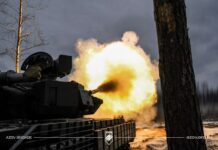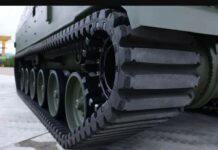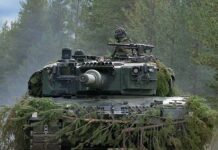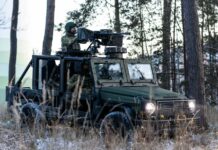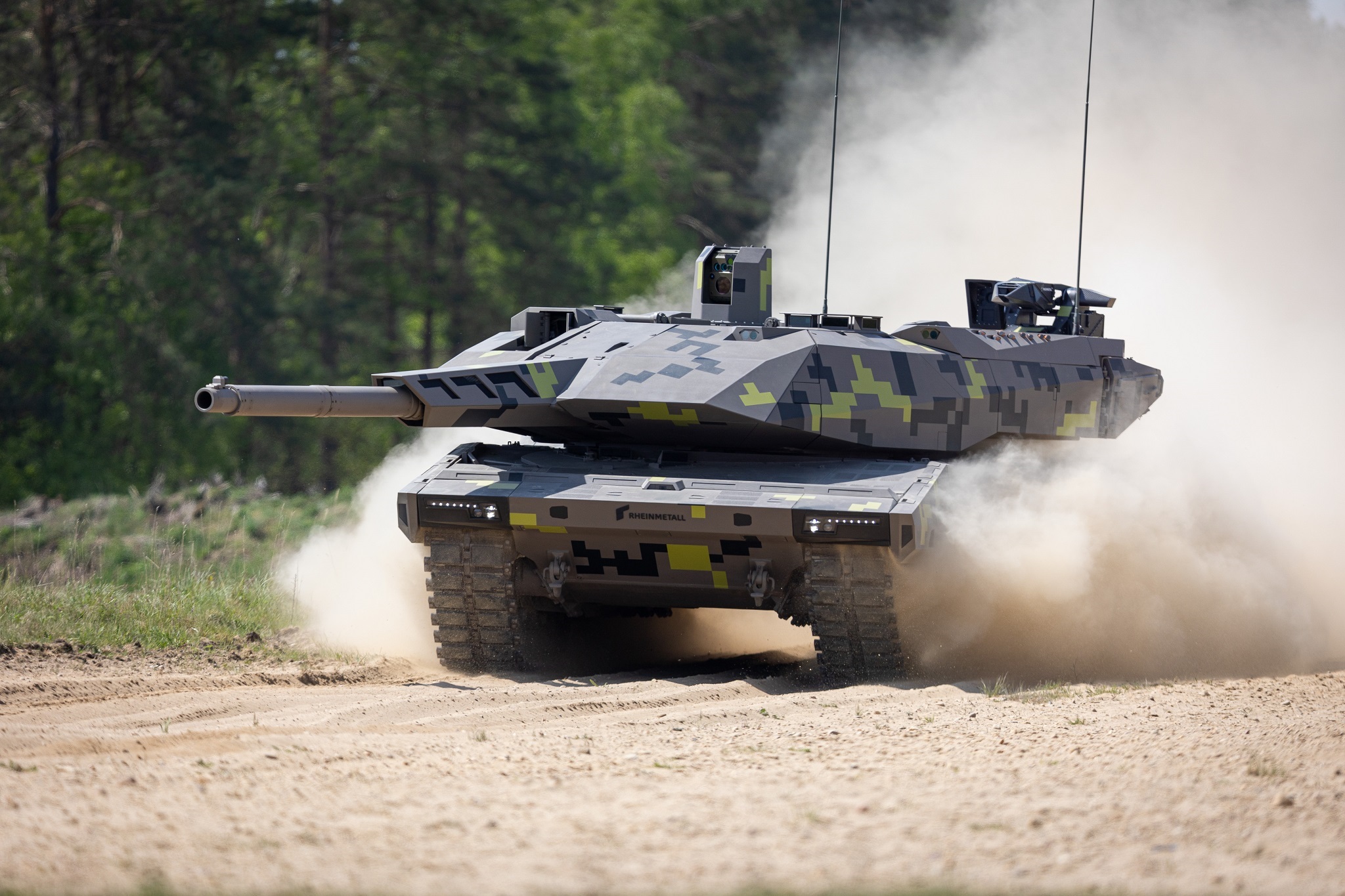
Future Main Battle Tanks
Christopher F Foss and Mark Cazalet
Main Battle Tanks (MBTs) have been around for just over 100 years and during that period they have been continuously evolving with improved firepower, survivability, and mobility. Whilst there have been a few new clean-sheet designs appearing, the trend in many countries is to upgrade their existing AFV platforms rather than develop or purchase new ones.
Europe
The most significant new-design MBT programme in Europe is the Franco-German MAIN GROUND COMBAT SYSTEM (MGCS) programme, due to enter service in approximately 2035 and expected to replace the currently deployed Krauss-Maffei Wegmann LEOPARD 2 and Nexter LECLERC MBT families.
In the past a number of European countries had the capability to design and manufacture an MBT, for example Sweden with the Stridsvagn 103 (commonly known as the S-tank), and Switzerland with the Panzer 61 and Panzer 68 designs, however over time this has declined, with European users consolidating procurement around just a few designs. In this vein, both Sweden and Switzerland opted for the German Krauss-Maffei Wegmann (KMW) LEOPARD 2, albeit modified variants to meet their own requirements.
However, EuroSatory 2022 offered a glimpse into the potential future European MBT design, with two noteworthy examples exhibited. The first was the ENHANCED MBT (EMBT) demonstrator developed by KNDS, which consists of KMW and Nexter. The second was the PANTHER KF51 MBT, developed by Rheinmetall.
The EMBT featured a heavily modified LEOPARD 2 hull fitted with a new two-person turret armed with a Nexter F1 CN120-26 120 mm L/52 smoothbore gun fed by a bustle-mounted autoloader with 22 ready rounds of ammunition, and compatible with Nexter’s forthcoming SHARD Armour-Piercing Fin-Stabilised Discarding Sabot (APFSDS) round. Although the main armament presented was the same as that of the LECLERC MBT, KNDS’ eventual offer for the MGCS programme is expected to feature the larger ASCALON 140 mm gun developed by Nexter, and indeed during Eurosatory 2022, KNDS stated that the EMBT’s turret was ready for integration with ASCALON.
In terms of secondary armament, EMBT was provided with a 12.7 mm coaxial heavy machine gun (HMG) with 680 ready rounds, as well as a combined commander’s panoramic sight and remote weapon station (RWS) armed with a 7.62 mm machine gun (MG) with 800 ready rounds. The tank is also fitted with a secondary RWS in the form of the ARX30, primarily intended to provide the vehicle with an organic counter-UAV capability. The ARX30 is armed with Nexter’s 30 M 781 electrically operated revolver cannon which has previously been used to arm the EUROCOPTER TIGER attack helicopter. The automatic cannon is chambered in the 30 mm × 113 cartridge, and provided with 150 ready rounds.
In addition to the commander and gunner in the turret it also has a driver and ‘system operator’ positioned in the hull, with the latter responsible for operating the ARX30 RWS, battle management system (BMS), and potentially any UAVs deployed by the vehicle. The crew concept is interesting, because while autoloaders permit getting rid of the fourth member of the crew, the armed forces of many countries have expressed an interest in retaining the fourth crew member, given their utility in various tasks such as track replacement or repairs. Given that the loading function can be automated away, retaining the fourth member of the crew requires finding new tasks to perform, and those tasks envisioned for the EMBT’s ‘System Operator’ would appear to be primarily aimed at a mix of protection against small aerial threats, and long-range situational awareness, thereby improving overall protection and reducing the cognitive burden on the commander.
In terms of protection, the tank was equipped with the Rafael TROPHY active protection system (APS), the PILAR V acoustic gunshot detector, the E-LAWS laser warning receiver (LWR) system and 14 GALIX grenade launchers, which can be loaded with obscurant smoke grenades and various other ammunition natures. Despite this growth in mission systems the EMBT also represented a reversal of the weight growth trend seen in modern AFVs, coming in at a combat weight of 61.5 tonnes, which is lower than many present-day MBTs.
The Rheinmetall PANTHER KF51 MBT similarly showcased a number of interesting features. The vehicle was based on a heavily modified LEOPARD 2 hull, and fitted with a brand new turret armed with the Rheinmetall 130 mm/L52 smoothbore gun, providing overmatch against most existing armour. The 130 mm gun has a depression and elevation range from -9° to +20°, and is fed by a bustle-mounted autoloader which is supplied with ammunition from two magazines each holding 10 rounds, each magazine occupying roughly half of the turret bustle. Rheinmetall stated that if required, one of the two magazines could be replaced with a pod housing four HERO 12 loitering munitions, to enable engagement of targets at beyond line-of-sight ranges.

Credit: Rheinmetall
In terms of secondary armament, the tank is provided with a coaxial 12.7 mm HMG with 250 ready rounds, and Rheinmetall’s Natter RWS armed with a 7.62 mm MG, provided with 2,500 ready rounds. The Natter is intended for providing protection against small UAVs and light ground targets.
The PANTHER’s default crewing assumption was for three crew, with a driver in the hull and a commander and gunner in the turret, however Rheinmetall graphics showed that a fourth crew member, referred to as a ‘specialist’, could be optionally provided with a crew station next to the driver in the hull if required. The ‘specialist’ position is envisaged to be for either for operating UAVs (similar to the ‘system operator’ in KNDS’ model), or as a wingman pilot, or company commander.
In terms of protection, the vehicle was fitted with Rheinmetall’s ROSY obscurant smoke grenade launcher system, and Rheinmetall claimed that the vehicle can be fitted with an APS providing protection against both anti-tank guided missiles (ATGMs) and Kinetic Energy (KE) projectiles, as well as Rheinmetall’s Top Attack Protection System (TAPS). However, the latter two appeared absent from the version displayed at Eurosatory. The KF51 PANTHER also appeared to have taken a major step toward armoured vehicle weight reduction, with Rheinmetall stating the vehicle’s combat weight was 59 tonnes.
Elsewhere, the UK has sought to upgrade its CHALLENGER 2 to the CHALLENGER 3 standard developed by RBSL, which brings a whole host of improvements including a completely new turret armed with a Rheinmetall’s Rh-120 L55A1 120 mm/L55 smoothbore gun, which will be capable of firing the DM73 and KE2020Neo (also referred to as DM73Neo) APFSDS rounds. It will also be provided with new gunner and commander sights from Thales as well as a front and rear thermal sights for the driver. In terms of protection, the vehicle’s new turret will be fitted with a new passive armour package, complemented by LWRs and ten obscurant smoke grenade launchers, as well as Rafael’s TROPHY hard-kill APS. These changes have come with a slight weight increase, with the final vehicle weighing approximately 66 tonnes, compared to the Challenger 2’s present 65 tonnes, depending on the armour package.

Credit: RBSL
However, despite being a leap forward for the UK’s tank capabilities, the timing of the upgrade is somewhat inconvenient. With first deliveries of the Challenger 3 to the British Army estimated for around 2029, the UK will be getting their new vehicles just a few years before major European allies are due to receive their next-generation MGCS tanks in 2035. As a result, the UK once again risks being late to the adoption of a new vehicle used by its allies.
Russia has maintained its independent tank design capability, but its budgets and capability to manufacture new technologies at scale have lagged behind. The most recent Russian MBT design is the T-14 ARMATA, which is produced by UralVagonZavod (UVZ) in Nizhny Tagil. It was first displayed during the Russian 9 May Victory Day Parade in 2015, and featured a number of interesting design decisions. Perhaps the most noteworthy was its arrangement of housing its three crew, consisting of commander, gunner and driver, inside a protected citadel at the front of the hull, and use of an unmanned turret armed with the 2A82-1M 125 mm gun, which is capable of firing the longer Vakuum-1 and Vakuum-2 APFSDS rounds.

Credit: Russian MoD
The decision to use an unmanned turret has allowed the tank to be significantly lighter than many of its contemporary designs, sitting at a combat weight of roughly 55 tonnes. However, outside of a batch of approximately 20 tanks produced for trials purposes, Russia thus far seems to have failed to launch serial production of the vehicle, instead preferring to rely on upgraded variants of its older tank designs, such as the T-72B3, T-80BVM, and T-90M. While all three of these have been used in the War in Ukraine, the T-14 trials vehicles have so far not made an appearance.
Asia
Outside of Europe, India, over an extended period developed the ARJUN Mk 1 and Mk 1A (previously known as Mk II) MBTs, but has so far demand for the vehicle has remained relatively low, with the bulk of the Indian MBT fleet consisting of the Russian T-72 and T-90 tanks. India’s Defence Research and Development Organisation (DRDO) is presently working on the ‘Future Ready Combat Vehicle’ programme which seeks a to develop a future MBT for India, with a requirement of 1,770 vehicles, and a target of entry into service by 2030. However, aside from a very ambitious list of requirements published in a May 2021 request for information (RFI), this programme has not so far demonstrated much progress, and it is considered unlikely to meet its 2030 in-service target.
China has become self-sufficient in the design, development and production of all types of AFV, including MBTs. However, despite this, the country has broadly focussed on modernising its armed forces for the near-term by introducing various models of present-generation tanks, including the ZTZ-96A, ZTZ-96B (also known as Type 96A/B), ZTZ-99, and ZTZ-99A (also known as Type 99/A) MBT family, and the ZTQ-15 (also known as Type 15) light tank family, as well as developing the VT-4 (formerly known as MBT-3000) for the export market.
Following on from their development of the K1 (105 mm) and K1A1 (120 mm) MBTs, South Korean company Hyundai Rotem developed the K2 BLACK PANTHER MBT. After some delays the K2 BLACK PANTHER entered service with South Korea and has also recently been ordered by Poland who will take delivery of 180 direct from South Korea, with another 800 of an upgraded version called K2PL due to be manufactured locally from 2026.
Hyundai Rotem are also studying future MBT concepts including the NEXT GENERATION MAIN BATTLE TANK (NG MBT) which was displayed in scale model form at Eurosatory 2022. Like the T-14 ARMATA, it is intended to be operated by a crew of two or three, seated in a protected citadel in the hull, with a remote turret. The main armament is envisaged as being a 130 mm smoothbore gun fed by an automatic loader, and supplemented by secondary armaments including a RWS with a laser weapon, and a pop-up launcher with two ATGMs in the turret bustle. In a further similarity with T-14, the vehicle is intended to weigh only 55 tonnes, which is possible due to the use of a remote turret which does not require as much passive protection. The vehicle is also intended to be fitted with a hard-kill APS, with four effectors mounted in each of two traversable launchers which are mounted above either of the turret cheeks. These are supplemented by 16 obscurant smoke grenade launchers, eight of which are mounted on either side of the bustle.

Credit: Christopher F Foss
Middle East
The Israel Defense Force (IDF) has more high intensity ground manoeuvre warfare experience than many countries and have continuously developed their MERKAVA MBT family. However, so far Israel appears content to continue upgrading their existing MBTs, with the MERKAVA Mk4 ‘BARAK’ standard due to enter service soon, and focussing their future vehicle development efforts on the CARMEL family. Carmel is set to be a much lighter vehicle family, which will in effect be based around an infantry fighting vehicle (IFV) variant as the primary combat variant. Although the lack of plans for a future tank design may seem like a risky move, others have gone further than Israel, with the United States Marine Corps (USMC) already having deactivated their last M1A1 Abrams MBT unit in 2021.
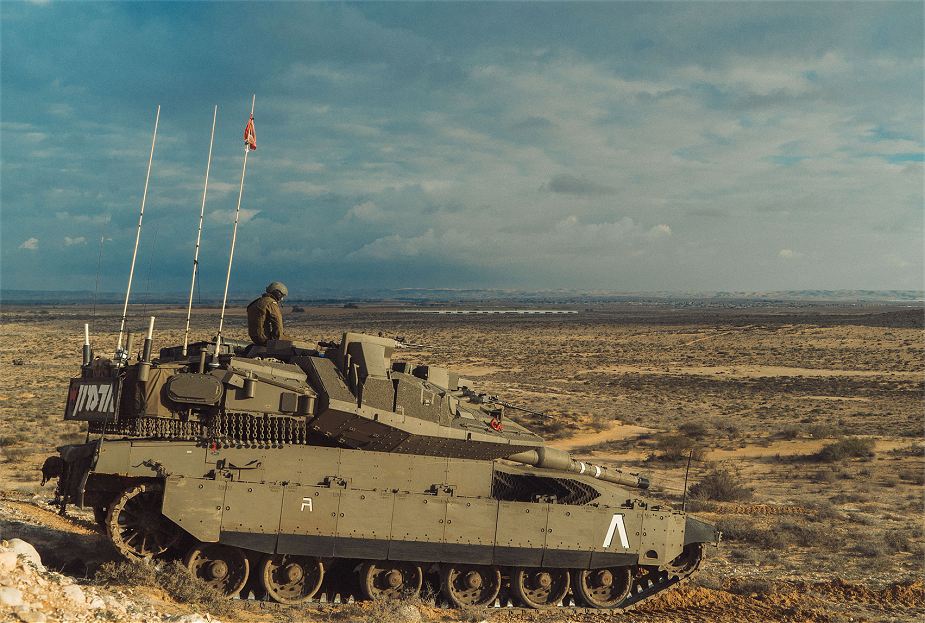
Credit: IDF
Turkey has mainly focussed on developing a capability to domestically manufacture a modern, contemporary MBT design. In this vein, the ALTAY MBT was developed by Otokar, however but in the end the production contract was placed with the Turkish manufacturer BMC who have experience with wheeled AFVs rather than tracked AFVs. Despite aiming for a contemporary vehicle, Turkey plans for the ALTAY design to incorporate increasingly future-generation features over time, with an ALTAY T3 variant planned for 2024 due to feature an unmanned turret. It is therefore plausible that over time Turkey’s experience with the vehicle could eventually materialise into a true next-generation MBT design.

Credit: SSB
Closing Thoughts
On the whole, MBTs are under pressure in an age where extremely lethal and precise weapons are often able to overmatch passive protection. However, MBTs continue to evolve in various ways to meet these new challenges.
For starters, the main armament of future MBT designs are typically larger than the 120 mm or 125 mm of modern designs, with 130 mm or 140 mm calibres envisioned. While these provide increased lethality on target, the trade-off is that fewer rounds can be carried, and these will require an autoloader due to the larger munitions being too heavy for a human loader.
In terms of mobility, torsion bar suspension is giving way to hydro-pneumatic suspension, providing a better ride for the crew and a more stable firing platform for the gun. While at present composite rubber tracks have not yet reached the point where they can reliably bear the weight of an MBT, manufacturers such as Soucy are working on attaining this.
Perhaps most interesting is that after decades of weight growth, tank designs are finally beginning to shift the other way, with passive armour gradually beginning to give way to ‘left of boom’ solutions such as soft-kill and hard-kill APSs, and signature management. Additionally, with other technologies reaching maturity, such as unmanned turrets, or composite rubber tracks (CRTs), these have provided the potential for designers to create lighter designs while retaining high overall protection.
Challenges still remain, the lethality of modern weapons continues to broadly overmatch passive protection, and many of the new subsystems being added to vehicles have increased their power demands, requiring most contemporary designs to be fitted with an auxiliary power unit (APU) or power storage solutions to meet these increased power requirements, and to allow the vehicle to continue to operate when the main engine is switched off to conserve fuel. Despite the challenges posed by the modern battlefield, the MBT looks set to remain an important component of modern armed forces well into the future.
Christopher F Foss and Mark Cazalet







![MGCS status update The KNDS EMBT-ADT 140 technology demonstrator on display at the Eurosatory 2024 exhibition. This model featured the 140 mm configuration of the ASCALON gun. [Mark Cazalet]](https://euro-sd.com/wp-content/uploads/2025/08/EMBT-EDT-140_Mark-Cazalet-Kopie-218x150.jpg)


